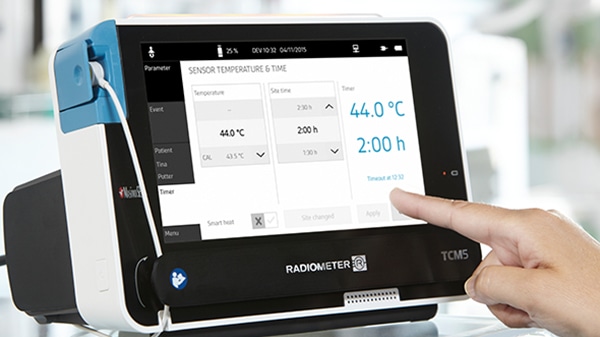TCM5 FLEX transcutaneous monitor supports your care of critically ill patients
The TCM5 FLEX transcutaneous monitor is a compact, easy-to-use solution that delivers accurate and continuous measurement of oxygenation (tcpO2) and ventilation (tcpCO2) status in neonatal, pediatric and adult patients in the ICU.
The surgical steel protected sensors measure tcpO2 and tcpCO2, SpO2 and pulse rate, delivering consistent and reliable results. Key features: Automatic temperature regulation Real-time information Visible alerts Compact and lightweight Large color touchscreen Spool for easy sensor cable management Sensor calibration chamber - sensor is always ready
Parameters
Pulse Oximetry: Pulse, SpO2
Transcutaneous blood gas: tcpCO2, tcpO2
Image Credit: Radiometer
A transcutaneous monitor that helps you focus on patient care
The TCM5 FLEX transcutaneous monitor has an intuitive user interface and built-in tutorials that make it easy to set up, learn and use.
Compact and practical, the TCM5 FLEX monitor comes with a color touchscreen. Clear on-screen messages give you an immediate overview of measured parameters supporting patient care.
A clearly visible alarm bar on top of the monitor and on-screen icons alert you to changes in patient status. Real-time trending measurements allow for immediate clinical intervention to critical changes in patient status. [1]
The TCM5 transcutaneous monitor
Video Credit: Radiometer
Transcutaneous monitor with reliable sensors
The gold-plated sensors measure tcpO2 and tcpCO2, SpO2 and pulse rate, delivering consistent and reliable results. The sensors have a variety of fixation options helping to improve patient comfort.
Automatic calibration of the sensor reduces preparation time and improves workflow.
A dedicated sensor cable spool makes cable management easy, keeping your department clutter-free.
The TCM5 FLEX monitor allows you to get a real-time view of changes in the child’s physiology, changes in their lung status and ventilation."
Dr. Sijo Francis, Consultant Neonatologist, St. George’s University Hospitals NHS Foundation Trust
Transcutaneous monitoring enables careful monitoring of the neonate
Transcutaneous monitoring – or continuous, non-invasive monitoring – of tcpO2 and tcpCO2 can detect changes in the oxygenation and ventilation status of neonates. [2, 3, 4, 5]
Transcutaneous monitoring complements arterial and capillary blood sampling. You can reduce the number of blood samples and limit unnecessary handling of the infant, while ensuring careful control of your patient. [3, 4, 5, 6, 7]
The TCM5 FLEX transcutaneous monitor helps reduce patient discomfort with system defined limits of site time vs. temperature to reduce the risk of harm from the heated electrode by predefined combinations of time and temperature.
Continuous transcutaneous monitoring of patients in the ICU
Patients with acute respiratory failure and respiratory pump insufficiency are often treated with mechanical ventilation. Real-time monitoring offers a reliable approach to titrate ventilator settings without repeated blood sampling.[8, 9, 10, 11]
Unlike blood gas sampling, transcutaneous monitoring provides continuous information on CO2 levels allowing for proactive, rather than reactive ventilator adjustments.[10]
Transcutaneous monitoring improves patient care by reducing the need for blood samples, thereby reducing patient discomfort.[7, 10]
Weaning and extubation decisions may be made based on tcpCO2 measurement alone.[10]
By being able to view continuous data instead of having to rely on periodic blood gas analysis, I feel fully confident in my ability to be precise and accurate so I can provide a higher level of care."
Dr. Marco Bardessono, Pulmonologist at the A.O.U. Citta della Salute e della Scienza hospital in Torino, Italy

Image Credit: Radiometer
References
1. Spelten O. Transcutaneous PTCCO2 measurement in combination with arterial blood gas analysis provides superior accuracy and reliability in ICU patients. J Clin Monit Comput (2017) 31:153–158.
2. Quine D, Stenson BJ. Does the monitoring method influence stability of oxygenation in preterm infants? A randomized crossover study of saturation versus transcutaneous monitoring. Arch Dis Child Fetal Neonatal 2008; 93.
3. Rüdiger M et al. A survey of transcutaneous blood gas monitoring among European neonatal intensive care units. BMC pediatrics 2005; 5, 30.
4. Sandberg KL et al. Transcutaneous blood gas monitoring during neonatal intensive care. Acta pæediatrica 2011; 100.
5. SØRENSEN L, BRAGE-ANDERSEN L, GREISEN G. Effects of the transcutaneous electrode temperature on the accuracy of transcutaneous carbon dioxide tension. Scandinavian Journal of Clinical and Laboratory Investigation 2011; 71, 7: 548-52.
6. Goenka A et al. Neonatal blood gas sampling methods. SAJCH 2012; 6, 1.
7. Lundstrøm K. E. Continous Blood gas monitoring in neonates and infants. neonatal INTENSIVE CARE 2003; 16, 4.
8. Jardins TD, Burton GB. Clinical manifestations and assessment of respiratory disease. 6th edition. Maryland Heights: MOSBY Elsevier, 2011; 125.
9. Windisch W et al. German National Guideline for Treating Chronic Respiratory Failure with Invasive and Non-Invasive Ventilation: Revised Edition 2017 – Part 1. Respiration 2018; 1-32.
10. Restrepo RD. AARC Clinical Practice Guideline: Transcutaneous Monitoring of Carbon Dioxide and Oxygen. Respiratory Care, 2012; 57, 11: 1956.
11. Jansenss JP. Transcutaneous PCO2 to Monitor Noninvasive Mechanical Ventilation in Adults. Chest 1998; 113: 768-73.